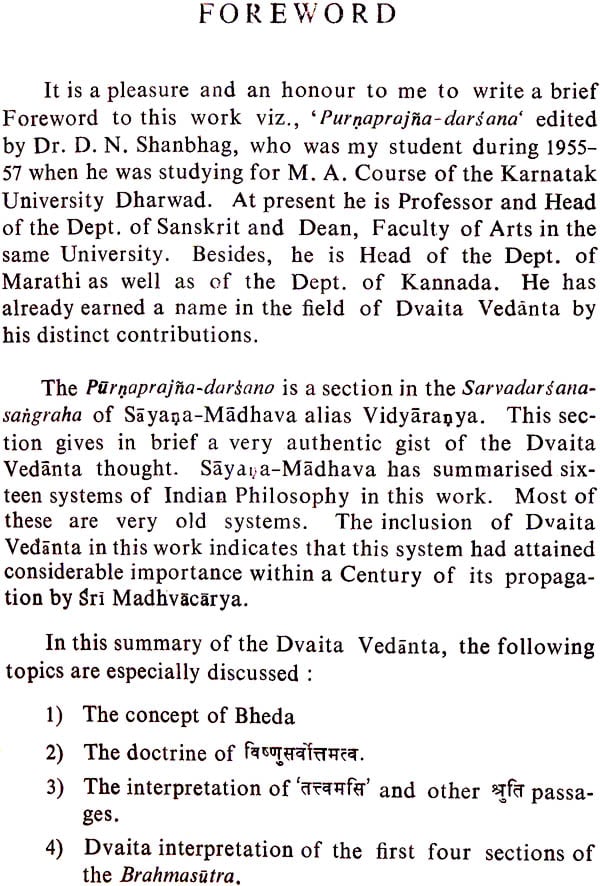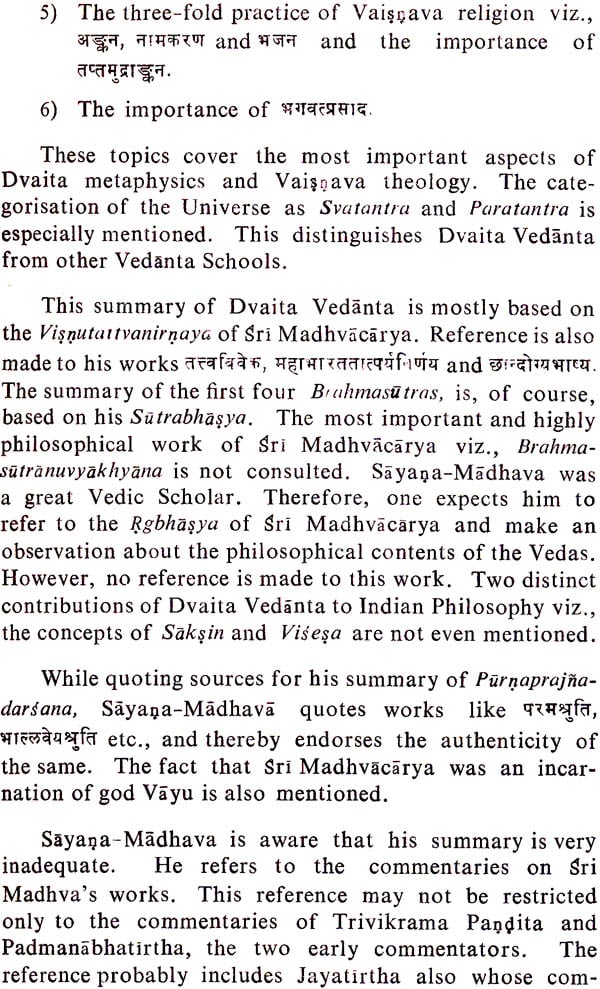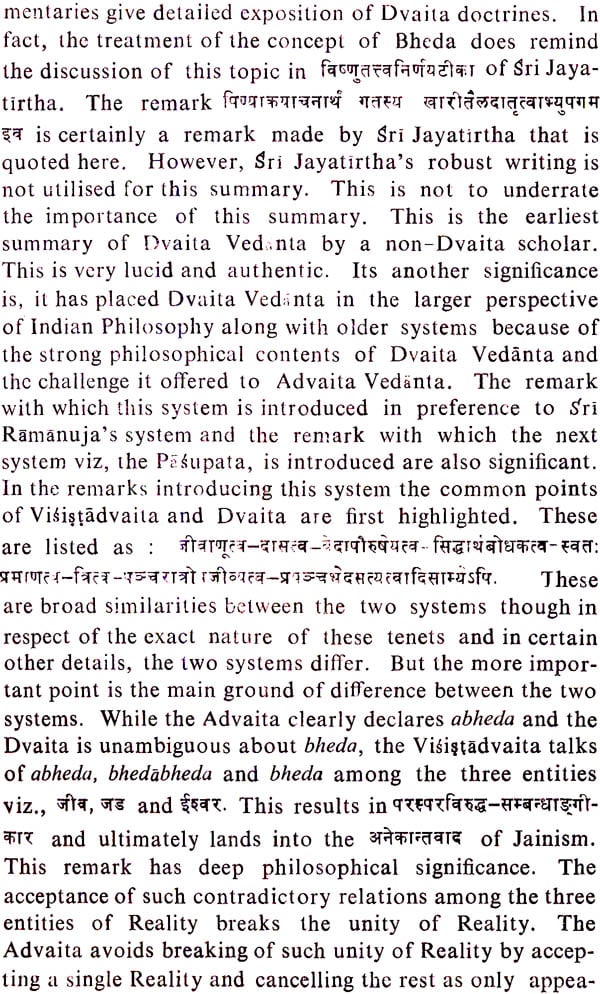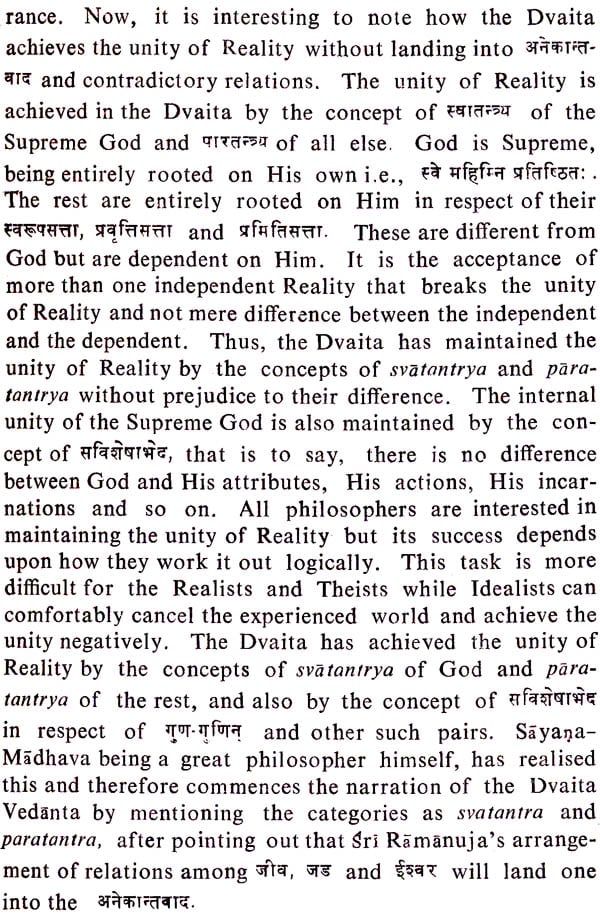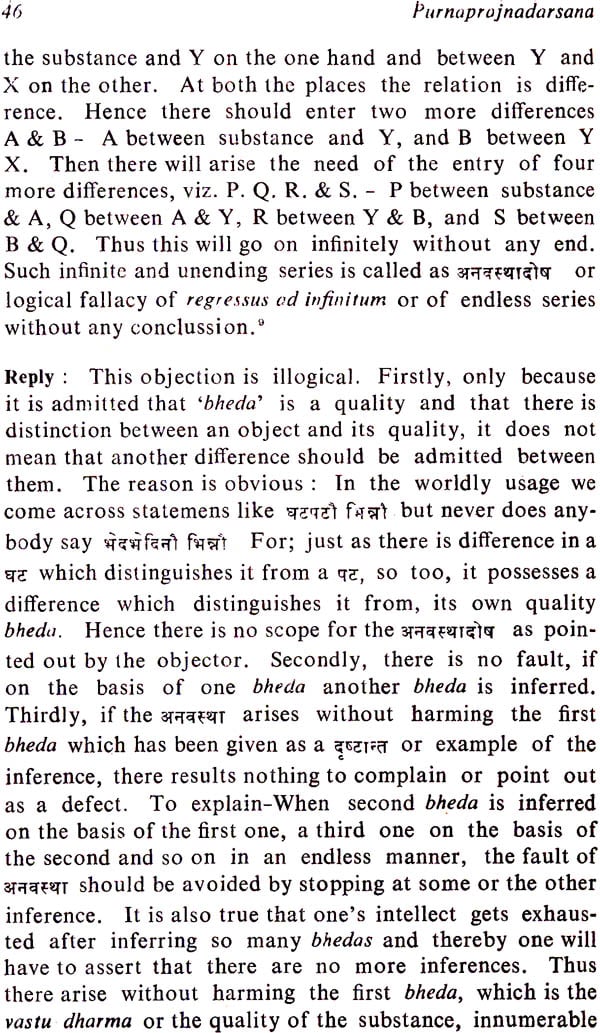
Purnaprajna-Darsana in Sarva Darsana Sangraha
Book Specification
| Item Code: | NAC415 |
| Author: | Dr. D.N. Shanbhag |
| Publisher: | Dvaita Vedanta Studies and Research Foundation |
| Language: | English |
| Edition: | 1992 |
| Pages: | 96 |
| Cover: | Paperback |
| Other Details | 8.5 Inch X 5.5 Inch |
| Weight | 100 gm |
Book Description
We are glad to present to the scholars and students of Dvaita Vedanta this small but very useful work viz., Purnaprojna-darsana edited by Dr. D.N. Shanbhag, Professor and Head of the Department of Sanskrit, and Dean Faculty of Arts, Karnatak University, Dharwad. This work is a section in the Sarvadarsanasangraha of Sayana-Madhava alias Vidyaranya, the well-known scholar of Advaita Vedanta. It is a first work on Dvaita Vedanta by a non-Dvaita scholar. Dr. Shanbhag has ably edited it K.T. Pandurangi has discussed the merits of this work in his Foreword. We are glad to publish it in the series of Dvaita Vedanta Foundation.
The Dvaita Vedanta Foundation is engaged in the Research and publication of Dvaita Vedanta works. We are interested in publishing original Sanskrit texts as well as Studies and translations in Kannada and English. We solicit co-operation of both scholars and readers in our endeavour. So far me have published 14 works. I am glad to record my appreciation of the good work done by Dr. D.N. Shanbhag and guidance given to him by Prof. Pandurangi.
It was very kind on the part of the University Grants Commission (IJGC) that it sanctioned in Nov. 1990, Programme of Department of Special Assistance to the Department of Studies in Sanskrit (Karnatak University, Dharwad) of which I happen to be the Chairman (Head). This DSA Programme was aimed at conducting advanced research in two thrust areas viz. I. Sanskrit Literature and Literary Criticism; and 2. Vedanta System of Philosophy.
Under this DSA Programme I thought of bringing to light the doctrines of the Dvaita System of Vedanta Philosophy as expounded by non-Dvaita writers. During my research I found the chapter ‘Purnaprajna-Darsana’ contained in Sayana— Madhava’s ‘Sarvadarsanasangraha’ to be a fairly objective account of the Dvaita system. This chapter has been brought to light here for the first time with English Introduction and Notes. Hence, I am thankful to the authorities of the U. G. C. and of the Karnatak University, Dharwad.
I offer my hearty salutations to Prof. K.T. Pandurangi for blessing me with a concise and scholarly Foreword.
I am thankful to the authorities of the Dvaita Vedanta Studies and Research Foundation Bangalore for having accepted this work as one of its publications.
I am grateful to the Proprietor of Manohar Printing Press, Dharwad for completing the printing work at my convenience.
Lastly, the credit of all achievements of mine goes to God’s grace, blessings of elders and good-wishes of my well-wishers. I pray- “Let all the three continue with me throughout my life and bestow success on my endeavours.”
All comments on this work are cordially welcomed.
Our sacred mother—land, India, is reputed since the beginning of history for its immense wealth of several_ intellectual and spiritual currents. Many systems of philosophy as well as modes of worshipping God took their birth on Indian soil and fully blossomed because of freedom of thought as well as of worship which has all along been one of the fundamental features of Hinduism, Among several systems of Indian Philosophy VEDANTA is quite prominent and widespread. It has its own schools depending upon main doctrinal differences. Prominent schools are Dvaita, Advaita, Kevaladvaita, Visistadvalta, Dvaitadvaita and Saktivisistadvaita. Among them the school of Dvaita-Vedanta was propounded and propagated by Madhvacarya substantiating all his doctrines from evidences taken from ancient scriptures and in conformity with cogent reasoning corroborated by universal experience.
Madhvacarya: his life, date and works
Madhvacarya’s life and achievements have been narrated by Narayana Pandita in his work ‘Sumadhvavijaya’ which has been accepted as an authentic biography by ancient as well as modern scholars. Accordingly, Madhvacarya was born in Pajaka, a village near Udupi in the South Kanara District of the present Karnataka State. His father was Madhyagehabhatta and mother Vedavati. On his birth he was named as Vasudeva. Even as a child he showed signs of his occult powers and extra-ordinary intellectual faculties. After the Upanayana ceremony, he began to study ancient lore of Hindus, consisting of Vedas, Brahmanas, Aranyakas, Upanisads, Puranas, Ramayana, Mahabharata having Bhagavadgita as its constituent part, the Brabmasutras with their various interpretations and treatises dealing with various systems of Indian Philosophy. When Madhvacarya began his studies, the scholarly world had been enveloped by the monistic illusionism represented by the Mayavada of Sankaracarya and had accepted it as the real Indian philosophy advocated by ancient scriptures and other authoritative teachers through their compositions.
But Madhvacarya desired to differ from his contemporary scholars. His independent study of scriptures and other authorities made him feel that they do not uphold in any way the Mayavada of Sankaracarya. His in-depth study and scholarly research made him discover that the scriptures and other authoritative texts not only not propagate the Mayavada, but positively they all agree in declaring Realistic Theism and in proclaiming the Visnusarvottamatva or Over-all Supremacy of Lord Visnu. He became more and more convinced regarding this fundamental and eternal truth during his studies under Acyutapreksacarya. It is said that Acyutapreksacarya, the preceptor, started his lessons with the monistic work Istasiddhi of Vimuktatman and Madhvacarya, the pupil, pointed out manifold defects in the opening verse itself. As a result the preceptor began to reconsider his belief in monism.
Madhvacarya was initiated to asceticism by Acyutapreksacarya who named him ‘Purnabodha’ the equivalent of ‘Purnaprajna’ by which name his system came to be known as ‘Purnaprajnadarsana’. Thereafter he got the names ‘Anandatirtha’ and ‘Madhvacarya’ which are also very popular since several centuries.
As Madhvacarya was swimming against the current of Mayavada then prevailing in the intellectual world, he had to experience stiff opposition to his way of thinking and of interpreting the sacred works held as authoritative. But was more than a match to all. Narayana Pandita narrates that Madhvacarya defeated in disputations contemporary stalwarts like Vasudeva Pandita, Vidisimhha, and Buddhisagara. In his youth itself Madhvacarya began to tour throughout India propagating the truth of Visnusarvottamatva and converted to his fold many a scholar like Sobhanabhatta who became Padmanabhatirtha, and Svami or Samasastri who became Naraharitirtha. Even his preceptor Acyutapreksacarya became a convert. Trivikrama Panditacarya, father of Narayana Pandita also became a follower of Madhvacarya. All these events prove the force of Madhvacarya’s vindication of his glorious Realistic Theism.
Besides the firm establishment of his philosophical doctrines through his scholarly and well—argued works, Madhvacarya introduced a major change in the mode of sacrifices whereby the flour- made animals were substituted for living animals. Even one such sacrifice was actually performed with his brother as the sacrificer. This revolutionary change was introduced in spite of stiff Opposition of the contemporary priestly class. Further, Madhvacarya showed his extra—ordinary calibre by conversing in the Persian language itself with a Muslim ruler. He preached the rigorous observance of fasts on each Ekadasi day throughout the year. He installed the idol of Lord Krsa at Udupi, which has since then become a strong centre of the Dvaita Vedanta. He ordained the worship of this idol to eight ascetic youths and this tradition which has continued even to day is widely known as the tradition of Asta-Mathas of Udupi.
Thus accomplishing the aim of his human incarnation lie disappeared from this mortal world on the ninth day of the bright half of the month of Magha in Pingala Samavatsara corresponding to 1318 A.D.
Madhvacarya is believed to be the third incarnation of Vayudeva or Wind-god, the first two being the forms of Hanuman and of Bhima.
Date: There is no doubt about the date of Madhvacarya. Scholars have concluded that he lived from 1238 A.D. to 1318 A.D.
